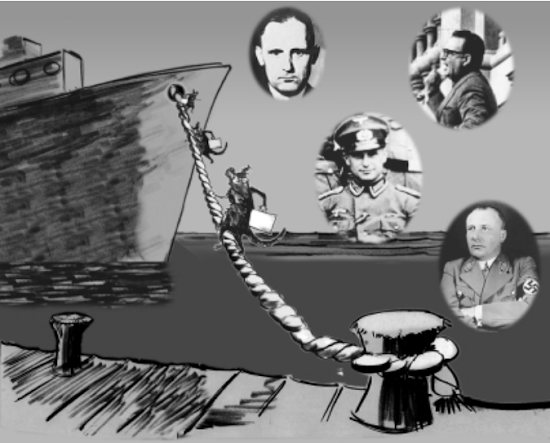On Aug. 10, 1944, about two months after the June 6 D-Day landing of the Allies in Normandy, France, less than a month after the unsuccessful July 20 attempted assassination of Adolf Hitler, and eight months before the death of U.S. President Franklin D. Roosevelt on April 12, 1945, a secret meeting took place in Nazi-occupied Strasbourg, France at the plush Maison Rouge Hotel, to plot the survival and eventual resurgence of the Nazi apparatus in the post-war period. The meeting was organized by Martin Bormann, the head of the Nazi Party Chancellery, who became Hitler’s designated successor.
Although Bormann did not personally attend the conference, he was represented by Dr. Friedrich Scheid, who was a lieutenant-general in the Waffen-SS and also a director of the industrial company Hermsdorf & Schomburg. In 1942, Scheid held an important position in Albert Speer’s Ministry of Armaments and Munitions, and at the end of 1942, I.G. Farben’s Dr. Walther Schieber, Chief of the Armaments Delivery Office, put him in charge of the bureau of “Industrial Independence,” in which position he had far-reaching responsibility for the Nazi arms industry.
Before the meeting, Bormann had confided to Dr. Scheid, “The steps to be taken as a result of this meeting will determine the post-war future of Germany. German industry must realize that the war cannot now be won, and must take steps to prepare for a post-war commercial campaign which will in time ensure the economic resurgence of Germany.”
According to an agent who attended the meeting and who was described as someone who “had worked for the French on German problems since 1916,” Dr. Scheid told participants on behalf of Bormann: “The battle of France is lost to Germany and now the defense of the Siegfried Line is the main problem. . . . From now on, German industry must take steps in preparation for a post-war commercial campaign, with each industrial firm making new contacts and alliances with foreign firms. This must be done individually and without attract ing any suspicion. However, the party and the Third Reich will stand behind every firm.”
Scheid continued: “The ground must now be laid on the financial level for borrowing considerable sums from foreign countries after the war.” As an example of a practice which proved very useful in the past, he cited the fact that “patents for stainless steel belonged to the Chemical Foundation, Inc., New York, and the Krupp Company of Germany jointly and that the United States Steel Corporation, Carnegie Illinois, American Steel & Wire, National Tube, etc., were thereby under an obligation to work with the Krupp concern.” He also cited the Zeiss Company, the Leica Company, and the Hamburg-Amerika line as typical firms that had been especially effective in protecting German interests abroad and gave their New York addresses to the industrialists at this meeting. (more...)
The Nazi Rat-lines: Time to Rid America Of the ‘Dulles Complex’

No comments:
Post a Comment